Strategic Management of Singapore Airlines: Comprehensive Report
VerifiedAdded on 2023/06/15
|11
|2702
|460
Report
AI Summary
This report provides a comprehensive management analysis of Singapore Airlines, a prominent carrier publicly listed in Singapore. It delves into the airline's business nature, highlighting its global operations across 45 countries and 94 destinations, supported by a fleet of 102 aircraft. The analysis incorporates a PESTEL framework, evaluating political, economic, social, technological, environmental, and legal factors impacting the airline. Furthermore, Porter's five forces model is applied to assess competitive rivalry, the threat of new entrants and substitutes, and the bargaining power of suppliers and buyers. The report concludes with strategic recommendations for Singapore Airlines, focusing on developing new strategies, improving communication systems, market penetration, and targeting niche markets to enhance its competitive position and overall business operations. Desklib offers a wealth of similar reports and solved assignments for students.
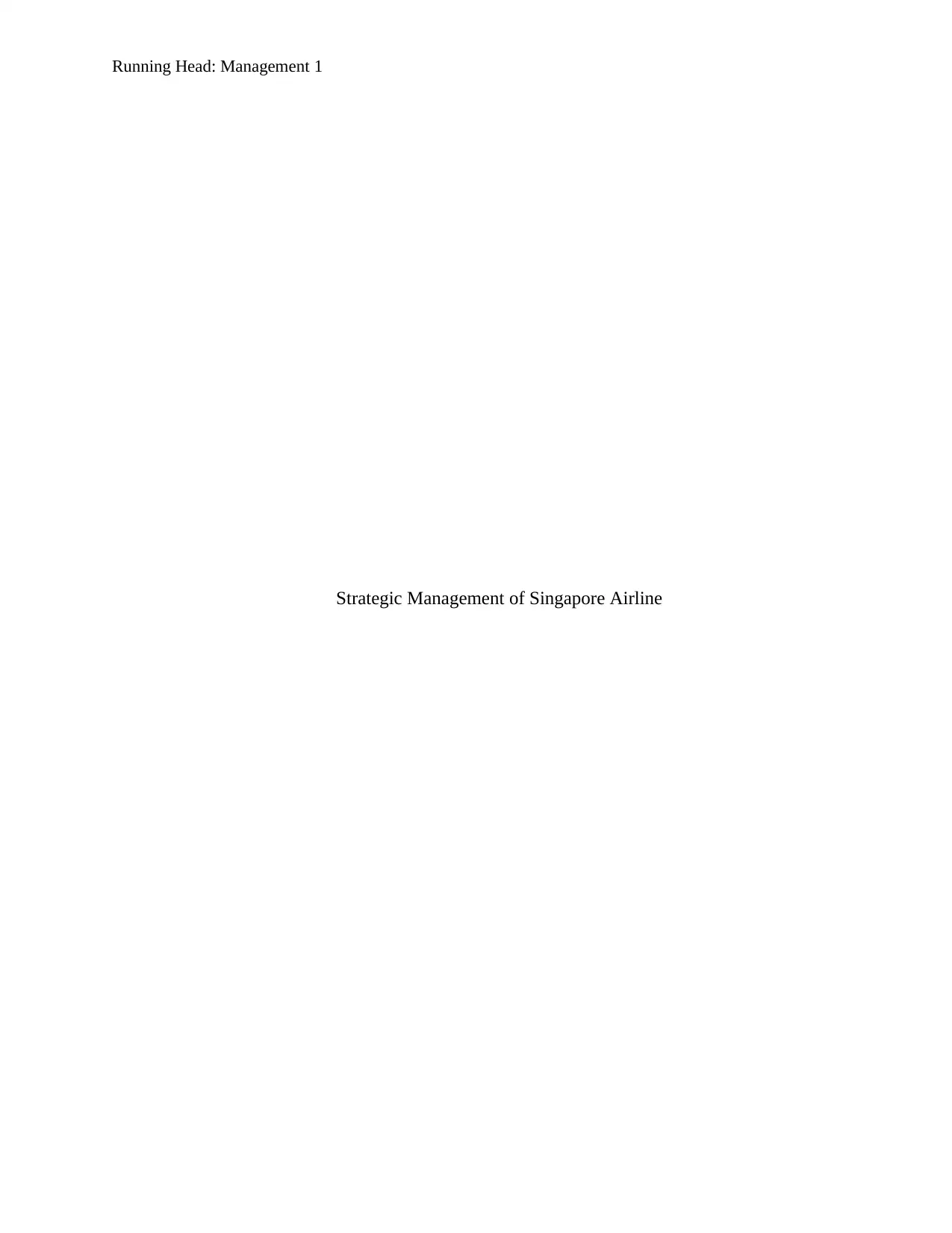
Running Head: Management 1
Strategic Management of Singapore Airline
Strategic Management of Singapore Airline
Paraphrase This Document
Need a fresh take? Get an instant paraphrase of this document with our AI Paraphraser
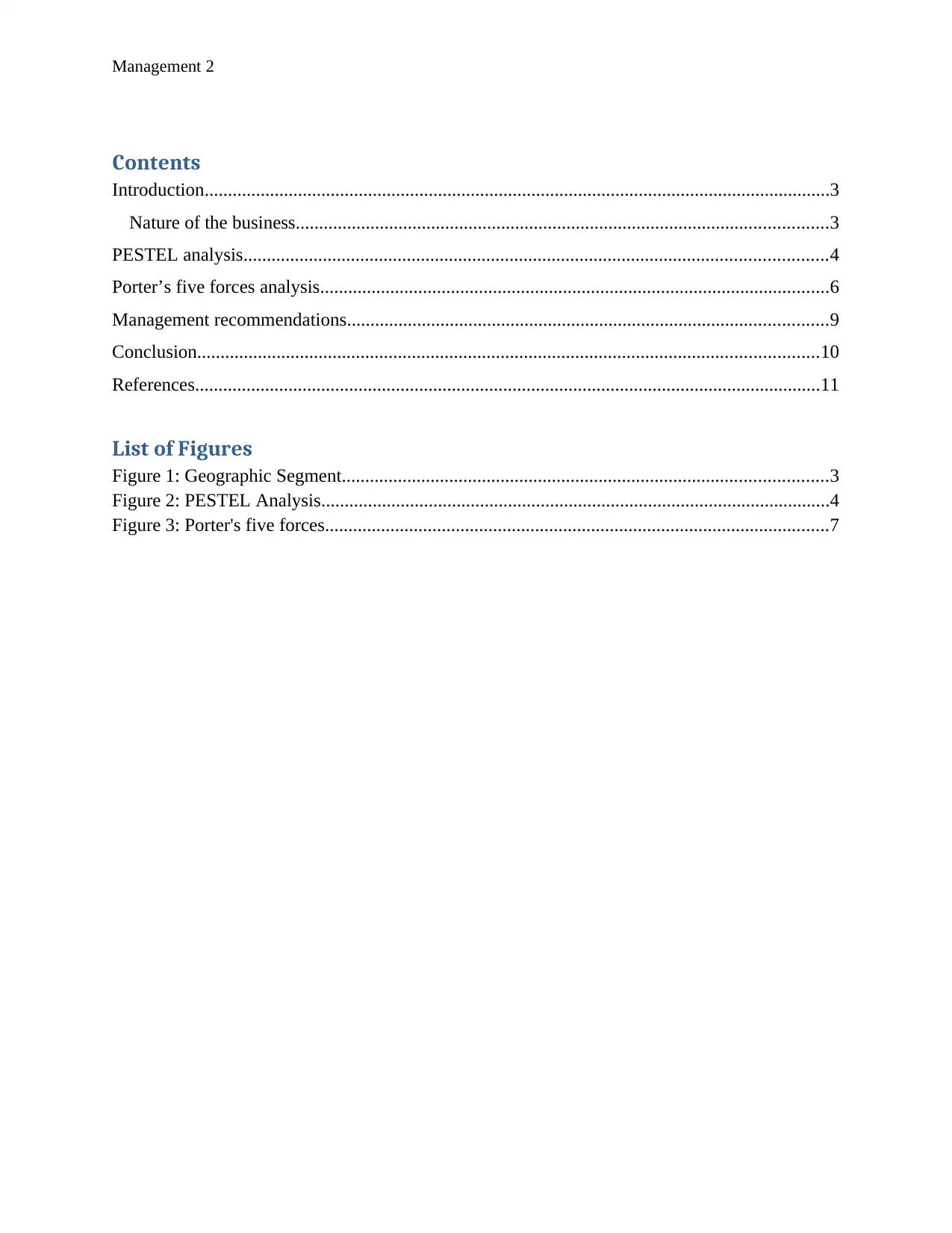
Management 2
Contents
Introduction......................................................................................................................................3
Nature of the business..................................................................................................................3
PESTEL analysis.............................................................................................................................4
Porter’s five forces analysis.............................................................................................................6
Management recommendations.......................................................................................................9
Conclusion.....................................................................................................................................10
References......................................................................................................................................11
List of Figures
Figure 1: Geographic Segment........................................................................................................3
Figure 2: PESTEL Analysis.............................................................................................................4
Figure 3: Porter's five forces............................................................................................................7
Contents
Introduction......................................................................................................................................3
Nature of the business..................................................................................................................3
PESTEL analysis.............................................................................................................................4
Porter’s five forces analysis.............................................................................................................6
Management recommendations.......................................................................................................9
Conclusion.....................................................................................................................................10
References......................................................................................................................................11
List of Figures
Figure 1: Geographic Segment........................................................................................................3
Figure 2: PESTEL Analysis.............................................................................................................4
Figure 3: Porter's five forces............................................................................................................7
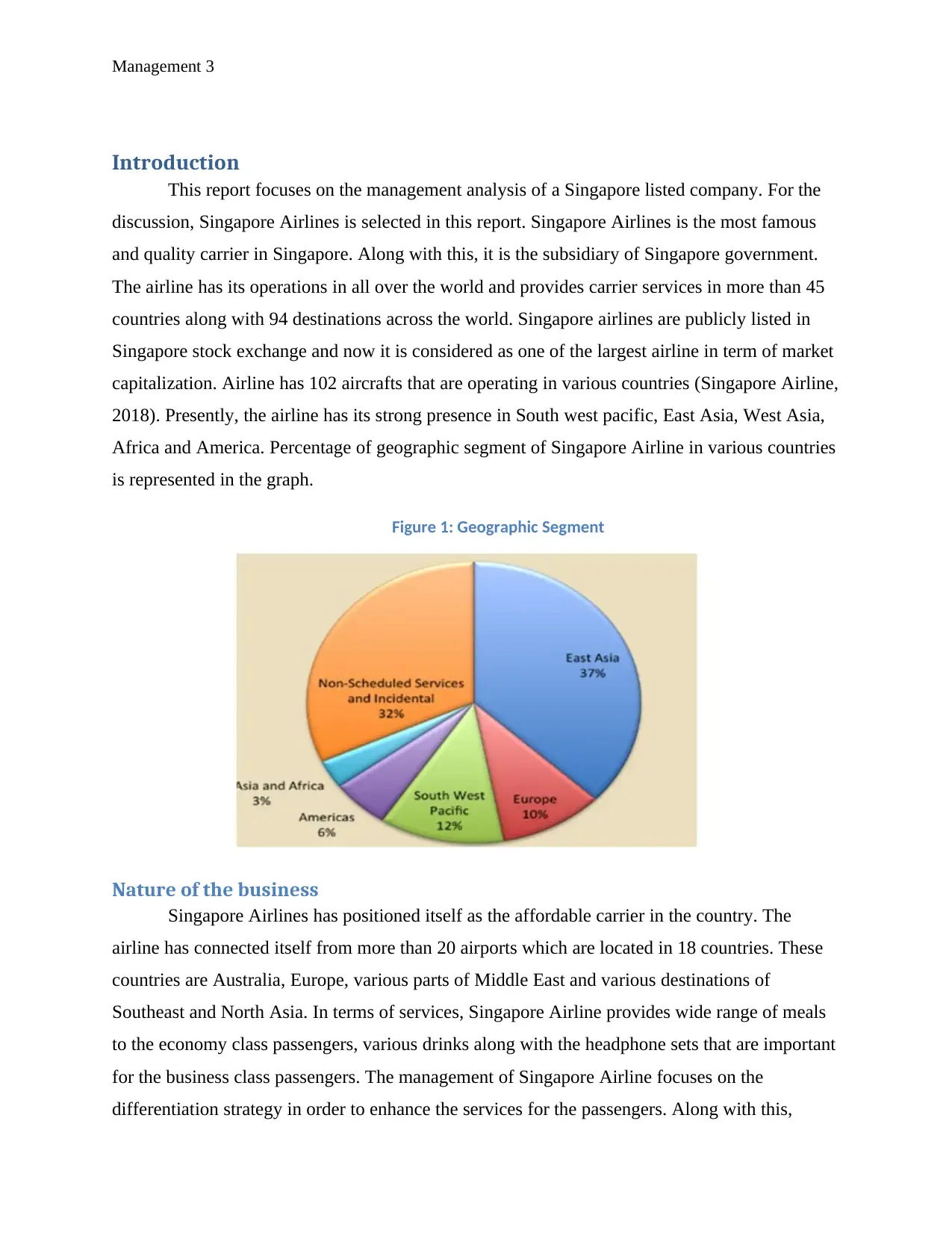
Management 3
Introduction
This report focuses on the management analysis of a Singapore listed company. For the
discussion, Singapore Airlines is selected in this report. Singapore Airlines is the most famous
and quality carrier in Singapore. Along with this, it is the subsidiary of Singapore government.
The airline has its operations in all over the world and provides carrier services in more than 45
countries along with 94 destinations across the world. Singapore airlines are publicly listed in
Singapore stock exchange and now it is considered as one of the largest airline in term of market
capitalization. Airline has 102 aircrafts that are operating in various countries (Singapore Airline,
2018). Presently, the airline has its strong presence in South west pacific, East Asia, West Asia,
Africa and America. Percentage of geographic segment of Singapore Airline in various countries
is represented in the graph.
Figure 1: Geographic Segment
Nature of the business
Singapore Airlines has positioned itself as the affordable carrier in the country. The
airline has connected itself from more than 20 airports which are located in 18 countries. These
countries are Australia, Europe, various parts of Middle East and various destinations of
Southeast and North Asia. In terms of services, Singapore Airline provides wide range of meals
to the economy class passengers, various drinks along with the headphone sets that are important
for the business class passengers. The management of Singapore Airline focuses on the
differentiation strategy in order to enhance the services for the passengers. Along with this,
Introduction
This report focuses on the management analysis of a Singapore listed company. For the
discussion, Singapore Airlines is selected in this report. Singapore Airlines is the most famous
and quality carrier in Singapore. Along with this, it is the subsidiary of Singapore government.
The airline has its operations in all over the world and provides carrier services in more than 45
countries along with 94 destinations across the world. Singapore airlines are publicly listed in
Singapore stock exchange and now it is considered as one of the largest airline in term of market
capitalization. Airline has 102 aircrafts that are operating in various countries (Singapore Airline,
2018). Presently, the airline has its strong presence in South west pacific, East Asia, West Asia,
Africa and America. Percentage of geographic segment of Singapore Airline in various countries
is represented in the graph.
Figure 1: Geographic Segment
Nature of the business
Singapore Airlines has positioned itself as the affordable carrier in the country. The
airline has connected itself from more than 20 airports which are located in 18 countries. These
countries are Australia, Europe, various parts of Middle East and various destinations of
Southeast and North Asia. In terms of services, Singapore Airline provides wide range of meals
to the economy class passengers, various drinks along with the headphone sets that are important
for the business class passengers. The management of Singapore Airline focuses on the
differentiation strategy in order to enhance the services for the passengers. Along with this,
⊘ This is a preview!⊘
Do you want full access?
Subscribe today to unlock all pages.

Trusted by 1+ million students worldwide
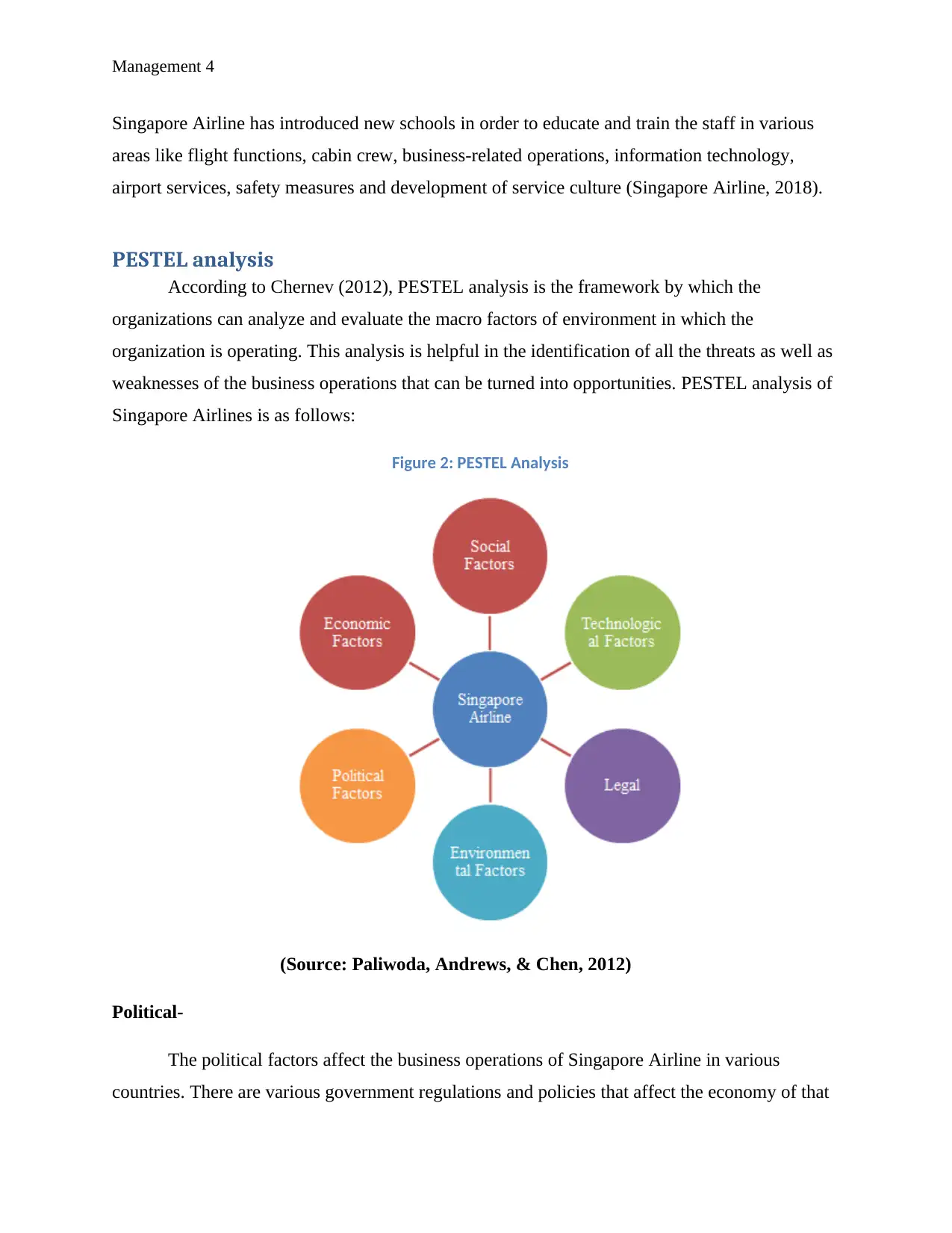
Management 4
Singapore Airline has introduced new schools in order to educate and train the staff in various
areas like flight functions, cabin crew, business-related operations, information technology,
airport services, safety measures and development of service culture (Singapore Airline, 2018).
PESTEL analysis
According to Chernev (2012), PESTEL analysis is the framework by which the
organizations can analyze and evaluate the macro factors of environment in which the
organization is operating. This analysis is helpful in the identification of all the threats as well as
weaknesses of the business operations that can be turned into opportunities. PESTEL analysis of
Singapore Airlines is as follows:
Figure 2: PESTEL Analysis
(Source: Paliwoda, Andrews, & Chen, 2012)
Political-
The political factors affect the business operations of Singapore Airline in various
countries. There are various government regulations and policies that affect the economy of that
Singapore Airline has introduced new schools in order to educate and train the staff in various
areas like flight functions, cabin crew, business-related operations, information technology,
airport services, safety measures and development of service culture (Singapore Airline, 2018).
PESTEL analysis
According to Chernev (2012), PESTEL analysis is the framework by which the
organizations can analyze and evaluate the macro factors of environment in which the
organization is operating. This analysis is helpful in the identification of all the threats as well as
weaknesses of the business operations that can be turned into opportunities. PESTEL analysis of
Singapore Airlines is as follows:
Figure 2: PESTEL Analysis
(Source: Paliwoda, Andrews, & Chen, 2012)
Political-
The political factors affect the business operations of Singapore Airline in various
countries. There are various government regulations and policies that affect the economy of that
Paraphrase This Document
Need a fresh take? Get an instant paraphrase of this document with our AI Paraphraser
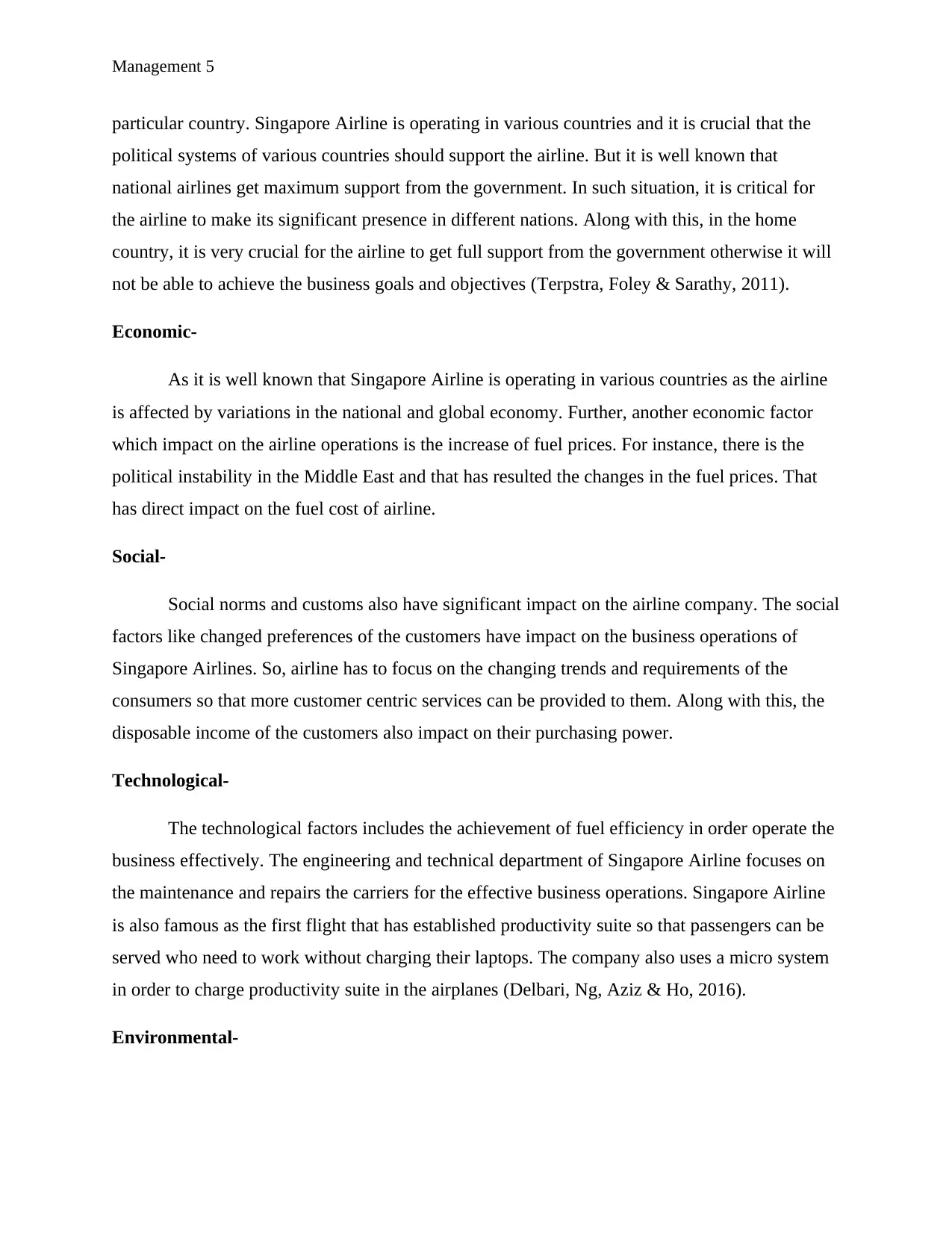
Management 5
particular country. Singapore Airline is operating in various countries and it is crucial that the
political systems of various countries should support the airline. But it is well known that
national airlines get maximum support from the government. In such situation, it is critical for
the airline to make its significant presence in different nations. Along with this, in the home
country, it is very crucial for the airline to get full support from the government otherwise it will
not be able to achieve the business goals and objectives (Terpstra, Foley & Sarathy, 2011).
Economic-
As it is well known that Singapore Airline is operating in various countries as the airline
is affected by variations in the national and global economy. Further, another economic factor
which impact on the airline operations is the increase of fuel prices. For instance, there is the
political instability in the Middle East and that has resulted the changes in the fuel prices. That
has direct impact on the fuel cost of airline.
Social-
Social norms and customs also have significant impact on the airline company. The social
factors like changed preferences of the customers have impact on the business operations of
Singapore Airlines. So, airline has to focus on the changing trends and requirements of the
consumers so that more customer centric services can be provided to them. Along with this, the
disposable income of the customers also impact on their purchasing power.
Technological-
The technological factors includes the achievement of fuel efficiency in order operate the
business effectively. The engineering and technical department of Singapore Airline focuses on
the maintenance and repairs the carriers for the effective business operations. Singapore Airline
is also famous as the first flight that has established productivity suite so that passengers can be
served who need to work without charging their laptops. The company also uses a micro system
in order to charge productivity suite in the airplanes (Delbari, Ng, Aziz & Ho, 2016).
Environmental-
particular country. Singapore Airline is operating in various countries and it is crucial that the
political systems of various countries should support the airline. But it is well known that
national airlines get maximum support from the government. In such situation, it is critical for
the airline to make its significant presence in different nations. Along with this, in the home
country, it is very crucial for the airline to get full support from the government otherwise it will
not be able to achieve the business goals and objectives (Terpstra, Foley & Sarathy, 2011).
Economic-
As it is well known that Singapore Airline is operating in various countries as the airline
is affected by variations in the national and global economy. Further, another economic factor
which impact on the airline operations is the increase of fuel prices. For instance, there is the
political instability in the Middle East and that has resulted the changes in the fuel prices. That
has direct impact on the fuel cost of airline.
Social-
Social norms and customs also have significant impact on the airline company. The social
factors like changed preferences of the customers have impact on the business operations of
Singapore Airlines. So, airline has to focus on the changing trends and requirements of the
consumers so that more customer centric services can be provided to them. Along with this, the
disposable income of the customers also impact on their purchasing power.
Technological-
The technological factors includes the achievement of fuel efficiency in order operate the
business effectively. The engineering and technical department of Singapore Airline focuses on
the maintenance and repairs the carriers for the effective business operations. Singapore Airline
is also famous as the first flight that has established productivity suite so that passengers can be
served who need to work without charging their laptops. The company also uses a micro system
in order to charge productivity suite in the airplanes (Delbari, Ng, Aziz & Ho, 2016).
Environmental-
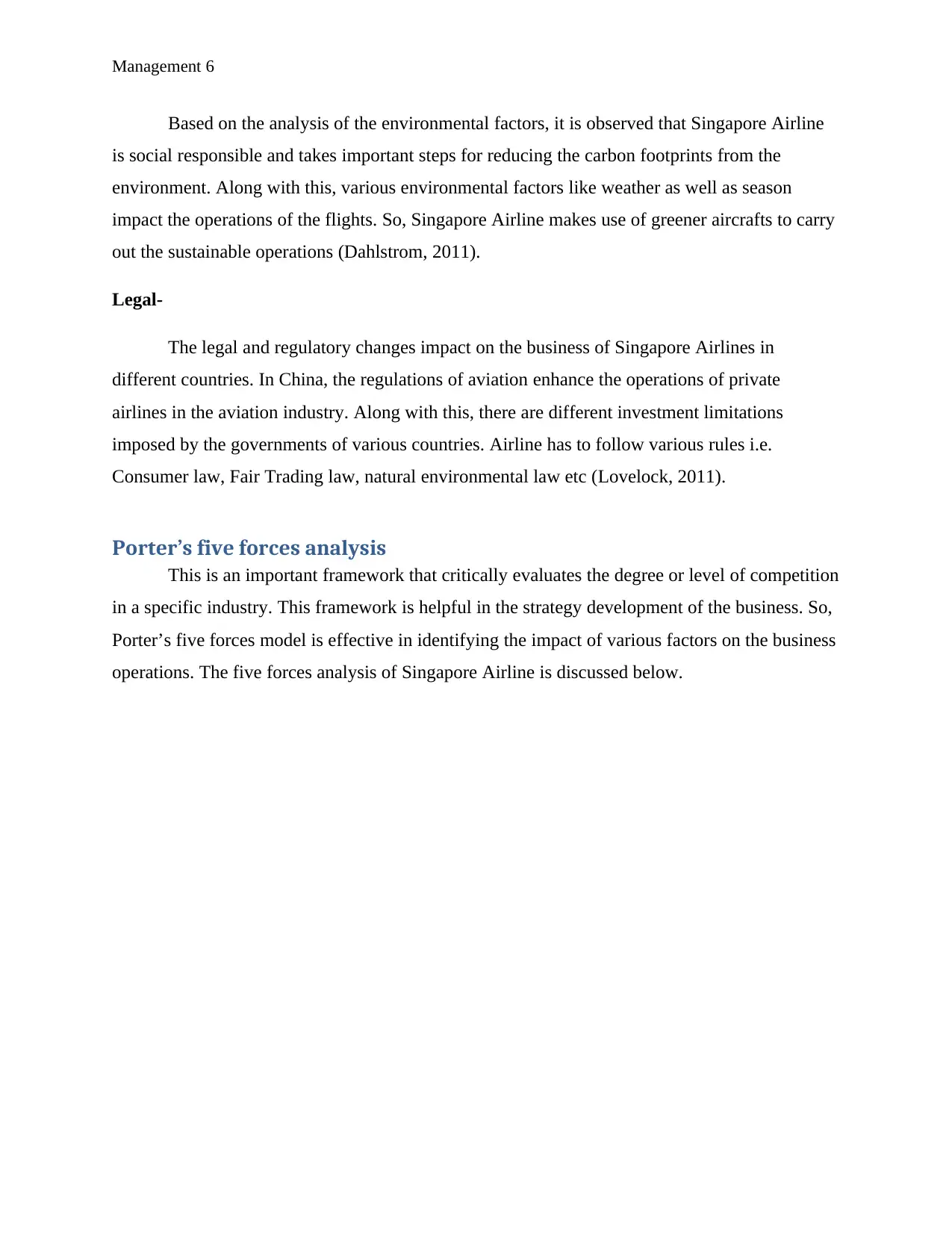
Management 6
Based on the analysis of the environmental factors, it is observed that Singapore Airline
is social responsible and takes important steps for reducing the carbon footprints from the
environment. Along with this, various environmental factors like weather as well as season
impact the operations of the flights. So, Singapore Airline makes use of greener aircrafts to carry
out the sustainable operations (Dahlstrom, 2011).
Legal-
The legal and regulatory changes impact on the business of Singapore Airlines in
different countries. In China, the regulations of aviation enhance the operations of private
airlines in the aviation industry. Along with this, there are different investment limitations
imposed by the governments of various countries. Airline has to follow various rules i.e.
Consumer law, Fair Trading law, natural environmental law etc (Lovelock, 2011).
Porter’s five forces analysis
This is an important framework that critically evaluates the degree or level of competition
in a specific industry. This framework is helpful in the strategy development of the business. So,
Porter’s five forces model is effective in identifying the impact of various factors on the business
operations. The five forces analysis of Singapore Airline is discussed below.
Based on the analysis of the environmental factors, it is observed that Singapore Airline
is social responsible and takes important steps for reducing the carbon footprints from the
environment. Along with this, various environmental factors like weather as well as season
impact the operations of the flights. So, Singapore Airline makes use of greener aircrafts to carry
out the sustainable operations (Dahlstrom, 2011).
Legal-
The legal and regulatory changes impact on the business of Singapore Airlines in
different countries. In China, the regulations of aviation enhance the operations of private
airlines in the aviation industry. Along with this, there are different investment limitations
imposed by the governments of various countries. Airline has to follow various rules i.e.
Consumer law, Fair Trading law, natural environmental law etc (Lovelock, 2011).
Porter’s five forces analysis
This is an important framework that critically evaluates the degree or level of competition
in a specific industry. This framework is helpful in the strategy development of the business. So,
Porter’s five forces model is effective in identifying the impact of various factors on the business
operations. The five forces analysis of Singapore Airline is discussed below.
⊘ This is a preview!⊘
Do you want full access?
Subscribe today to unlock all pages.

Trusted by 1+ million students worldwide
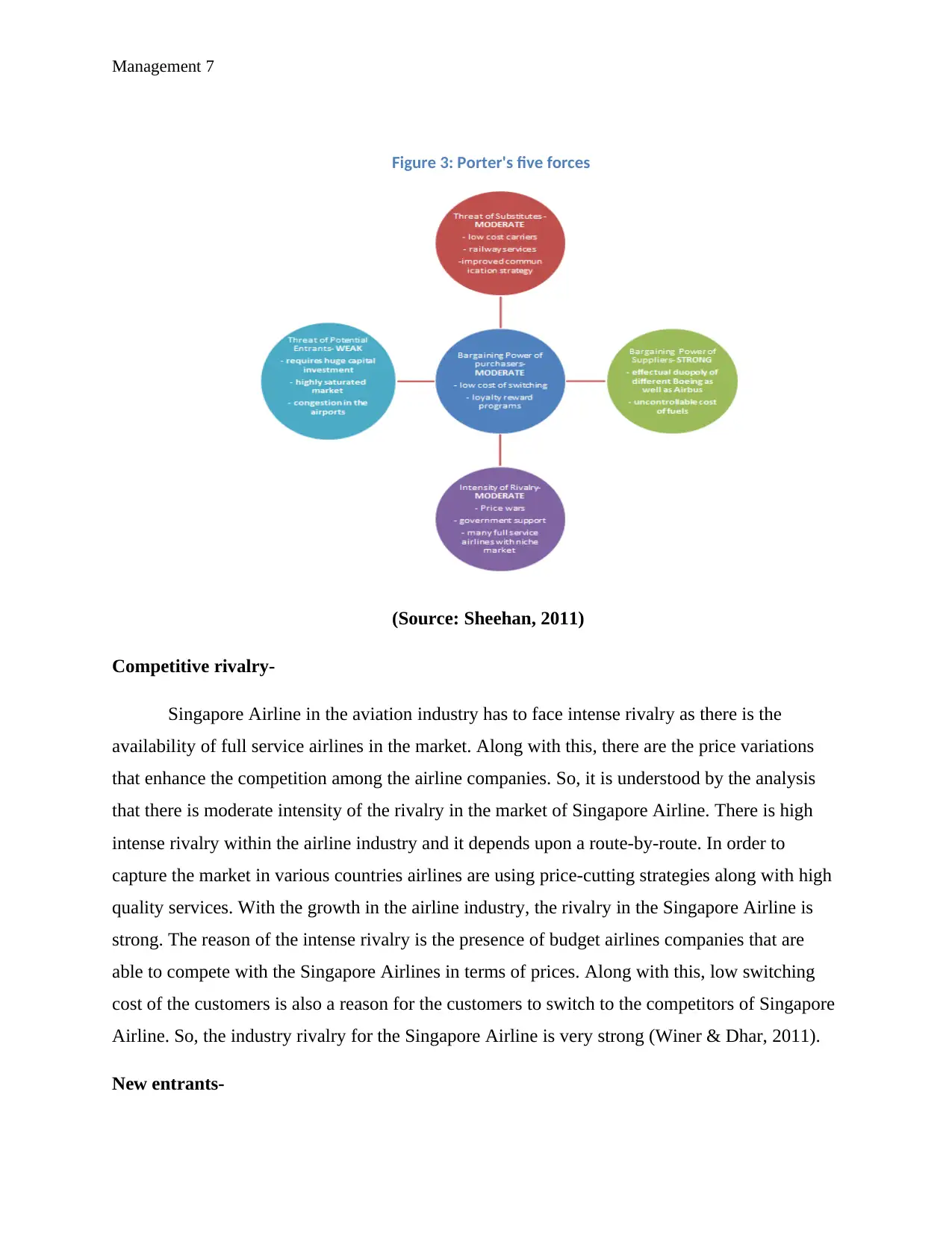
Management 7
Figure 3: Porter's five forces
(Source: Sheehan, 2011)
Competitive rivalry-
Singapore Airline in the aviation industry has to face intense rivalry as there is the
availability of full service airlines in the market. Along with this, there are the price variations
that enhance the competition among the airline companies. So, it is understood by the analysis
that there is moderate intensity of the rivalry in the market of Singapore Airline. There is high
intense rivalry within the airline industry and it depends upon a route-by-route. In order to
capture the market in various countries airlines are using price-cutting strategies along with high
quality services. With the growth in the airline industry, the rivalry in the Singapore Airline is
strong. The reason of the intense rivalry is the presence of budget airlines companies that are
able to compete with the Singapore Airlines in terms of prices. Along with this, low switching
cost of the customers is also a reason for the customers to switch to the competitors of Singapore
Airline. So, the industry rivalry for the Singapore Airline is very strong (Winer & Dhar, 2011).
New entrants-
Figure 3: Porter's five forces
(Source: Sheehan, 2011)
Competitive rivalry-
Singapore Airline in the aviation industry has to face intense rivalry as there is the
availability of full service airlines in the market. Along with this, there are the price variations
that enhance the competition among the airline companies. So, it is understood by the analysis
that there is moderate intensity of the rivalry in the market of Singapore Airline. There is high
intense rivalry within the airline industry and it depends upon a route-by-route. In order to
capture the market in various countries airlines are using price-cutting strategies along with high
quality services. With the growth in the airline industry, the rivalry in the Singapore Airline is
strong. The reason of the intense rivalry is the presence of budget airlines companies that are
able to compete with the Singapore Airlines in terms of prices. Along with this, low switching
cost of the customers is also a reason for the customers to switch to the competitors of Singapore
Airline. So, the industry rivalry for the Singapore Airline is very strong (Winer & Dhar, 2011).
New entrants-
Paraphrase This Document
Need a fresh take? Get an instant paraphrase of this document with our AI Paraphraser
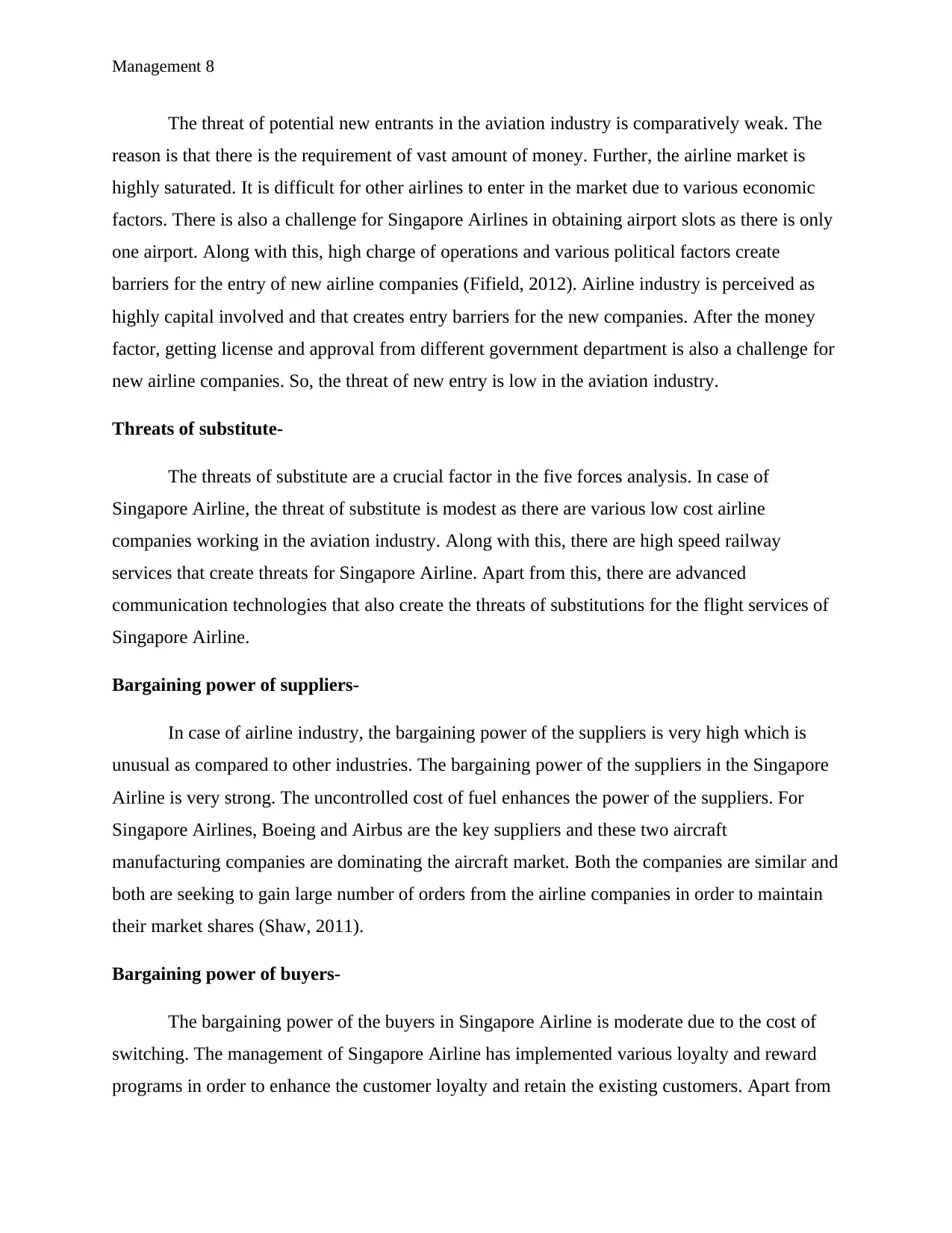
Management 8
The threat of potential new entrants in the aviation industry is comparatively weak. The
reason is that there is the requirement of vast amount of money. Further, the airline market is
highly saturated. It is difficult for other airlines to enter in the market due to various economic
factors. There is also a challenge for Singapore Airlines in obtaining airport slots as there is only
one airport. Along with this, high charge of operations and various political factors create
barriers for the entry of new airline companies (Fifield, 2012). Airline industry is perceived as
highly capital involved and that creates entry barriers for the new companies. After the money
factor, getting license and approval from different government department is also a challenge for
new airline companies. So, the threat of new entry is low in the aviation industry.
Threats of substitute-
The threats of substitute are a crucial factor in the five forces analysis. In case of
Singapore Airline, the threat of substitute is modest as there are various low cost airline
companies working in the aviation industry. Along with this, there are high speed railway
services that create threats for Singapore Airline. Apart from this, there are advanced
communication technologies that also create the threats of substitutions for the flight services of
Singapore Airline.
Bargaining power of suppliers-
In case of airline industry, the bargaining power of the suppliers is very high which is
unusual as compared to other industries. The bargaining power of the suppliers in the Singapore
Airline is very strong. The uncontrolled cost of fuel enhances the power of the suppliers. For
Singapore Airlines, Boeing and Airbus are the key suppliers and these two aircraft
manufacturing companies are dominating the aircraft market. Both the companies are similar and
both are seeking to gain large number of orders from the airline companies in order to maintain
their market shares (Shaw, 2011).
Bargaining power of buyers-
The bargaining power of the buyers in Singapore Airline is moderate due to the cost of
switching. The management of Singapore Airline has implemented various loyalty and reward
programs in order to enhance the customer loyalty and retain the existing customers. Apart from
The threat of potential new entrants in the aviation industry is comparatively weak. The
reason is that there is the requirement of vast amount of money. Further, the airline market is
highly saturated. It is difficult for other airlines to enter in the market due to various economic
factors. There is also a challenge for Singapore Airlines in obtaining airport slots as there is only
one airport. Along with this, high charge of operations and various political factors create
barriers for the entry of new airline companies (Fifield, 2012). Airline industry is perceived as
highly capital involved and that creates entry barriers for the new companies. After the money
factor, getting license and approval from different government department is also a challenge for
new airline companies. So, the threat of new entry is low in the aviation industry.
Threats of substitute-
The threats of substitute are a crucial factor in the five forces analysis. In case of
Singapore Airline, the threat of substitute is modest as there are various low cost airline
companies working in the aviation industry. Along with this, there are high speed railway
services that create threats for Singapore Airline. Apart from this, there are advanced
communication technologies that also create the threats of substitutions for the flight services of
Singapore Airline.
Bargaining power of suppliers-
In case of airline industry, the bargaining power of the suppliers is very high which is
unusual as compared to other industries. The bargaining power of the suppliers in the Singapore
Airline is very strong. The uncontrolled cost of fuel enhances the power of the suppliers. For
Singapore Airlines, Boeing and Airbus are the key suppliers and these two aircraft
manufacturing companies are dominating the aircraft market. Both the companies are similar and
both are seeking to gain large number of orders from the airline companies in order to maintain
their market shares (Shaw, 2011).
Bargaining power of buyers-
The bargaining power of the buyers in Singapore Airline is moderate due to the cost of
switching. The management of Singapore Airline has implemented various loyalty and reward
programs in order to enhance the customer loyalty and retain the existing customers. Apart from
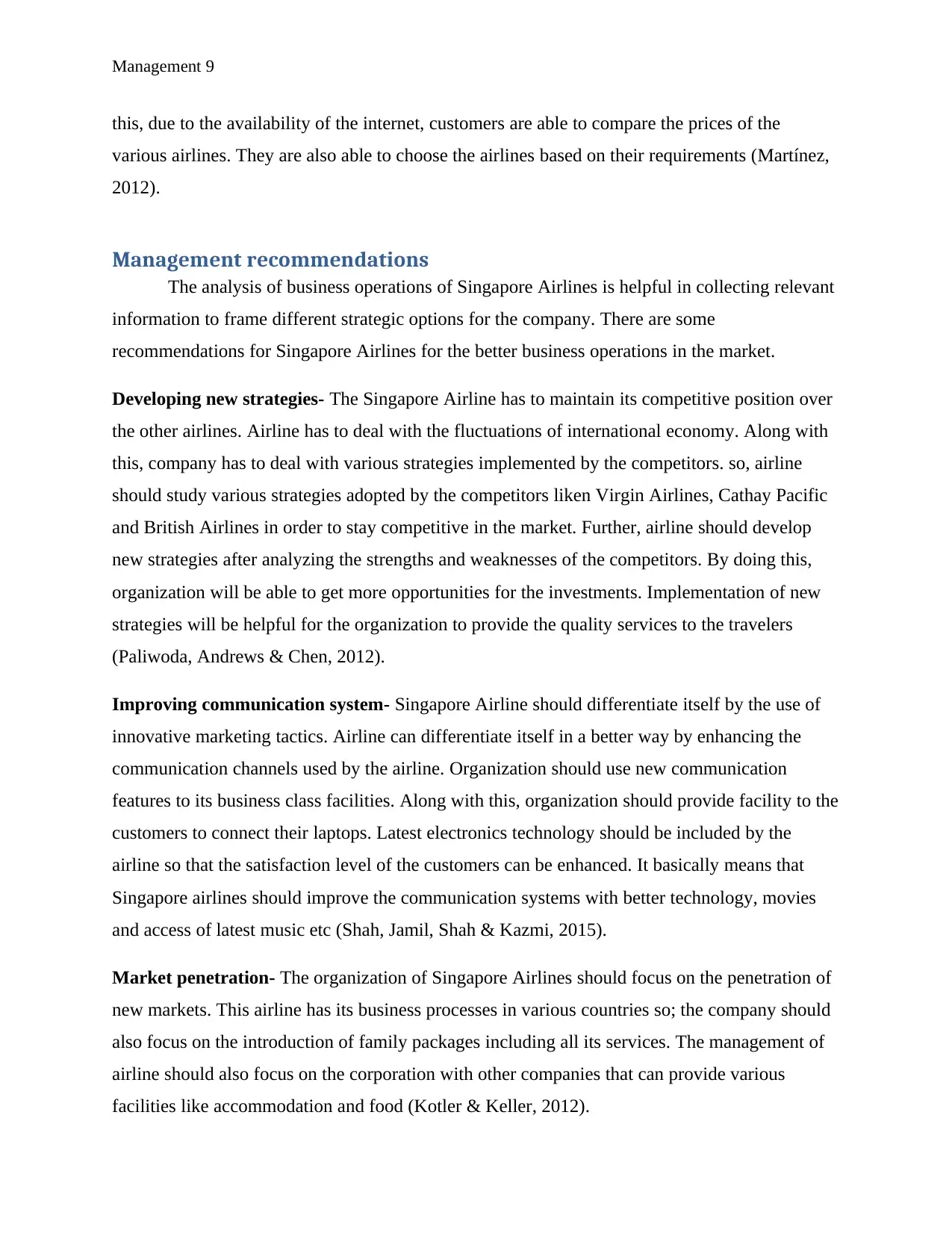
Management 9
this, due to the availability of the internet, customers are able to compare the prices of the
various airlines. They are also able to choose the airlines based on their requirements (Martínez,
2012).
Management recommendations
The analysis of business operations of Singapore Airlines is helpful in collecting relevant
information to frame different strategic options for the company. There are some
recommendations for Singapore Airlines for the better business operations in the market.
Developing new strategies- The Singapore Airline has to maintain its competitive position over
the other airlines. Airline has to deal with the fluctuations of international economy. Along with
this, company has to deal with various strategies implemented by the competitors. so, airline
should study various strategies adopted by the competitors liken Virgin Airlines, Cathay Pacific
and British Airlines in order to stay competitive in the market. Further, airline should develop
new strategies after analyzing the strengths and weaknesses of the competitors. By doing this,
organization will be able to get more opportunities for the investments. Implementation of new
strategies will be helpful for the organization to provide the quality services to the travelers
(Paliwoda, Andrews & Chen, 2012).
Improving communication system- Singapore Airline should differentiate itself by the use of
innovative marketing tactics. Airline can differentiate itself in a better way by enhancing the
communication channels used by the airline. Organization should use new communication
features to its business class facilities. Along with this, organization should provide facility to the
customers to connect their laptops. Latest electronics technology should be included by the
airline so that the satisfaction level of the customers can be enhanced. It basically means that
Singapore airlines should improve the communication systems with better technology, movies
and access of latest music etc (Shah, Jamil, Shah & Kazmi, 2015).
Market penetration- The organization of Singapore Airlines should focus on the penetration of
new markets. This airline has its business processes in various countries so; the company should
also focus on the introduction of family packages including all its services. The management of
airline should also focus on the corporation with other companies that can provide various
facilities like accommodation and food (Kotler & Keller, 2012).
this, due to the availability of the internet, customers are able to compare the prices of the
various airlines. They are also able to choose the airlines based on their requirements (Martínez,
2012).
Management recommendations
The analysis of business operations of Singapore Airlines is helpful in collecting relevant
information to frame different strategic options for the company. There are some
recommendations for Singapore Airlines for the better business operations in the market.
Developing new strategies- The Singapore Airline has to maintain its competitive position over
the other airlines. Airline has to deal with the fluctuations of international economy. Along with
this, company has to deal with various strategies implemented by the competitors. so, airline
should study various strategies adopted by the competitors liken Virgin Airlines, Cathay Pacific
and British Airlines in order to stay competitive in the market. Further, airline should develop
new strategies after analyzing the strengths and weaknesses of the competitors. By doing this,
organization will be able to get more opportunities for the investments. Implementation of new
strategies will be helpful for the organization to provide the quality services to the travelers
(Paliwoda, Andrews & Chen, 2012).
Improving communication system- Singapore Airline should differentiate itself by the use of
innovative marketing tactics. Airline can differentiate itself in a better way by enhancing the
communication channels used by the airline. Organization should use new communication
features to its business class facilities. Along with this, organization should provide facility to the
customers to connect their laptops. Latest electronics technology should be included by the
airline so that the satisfaction level of the customers can be enhanced. It basically means that
Singapore airlines should improve the communication systems with better technology, movies
and access of latest music etc (Shah, Jamil, Shah & Kazmi, 2015).
Market penetration- The organization of Singapore Airlines should focus on the penetration of
new markets. This airline has its business processes in various countries so; the company should
also focus on the introduction of family packages including all its services. The management of
airline should also focus on the corporation with other companies that can provide various
facilities like accommodation and food (Kotler & Keller, 2012).
⊘ This is a preview!⊘
Do you want full access?
Subscribe today to unlock all pages.

Trusted by 1+ million students worldwide
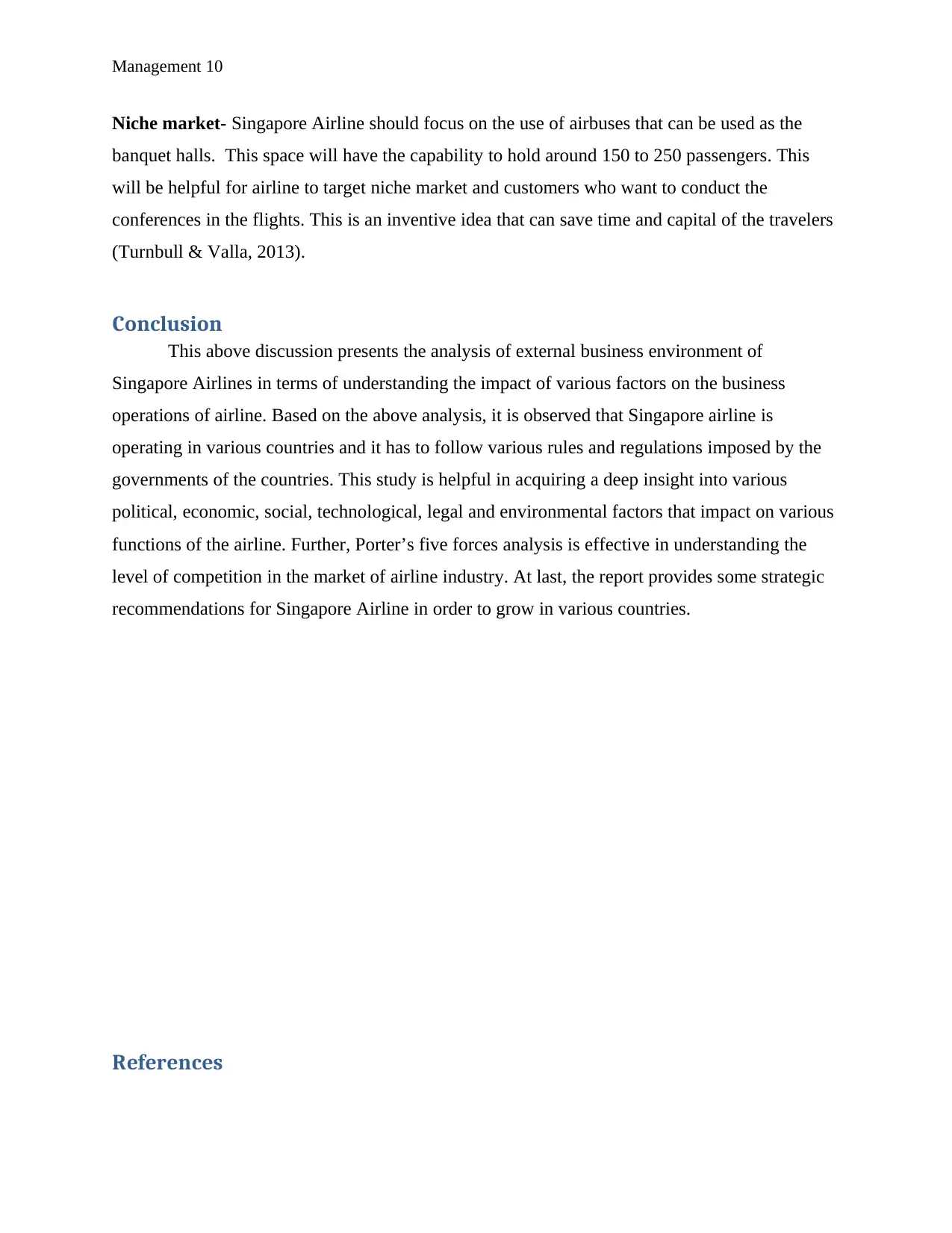
Management 10
Niche market- Singapore Airline should focus on the use of airbuses that can be used as the
banquet halls. This space will have the capability to hold around 150 to 250 passengers. This
will be helpful for airline to target niche market and customers who want to conduct the
conferences in the flights. This is an inventive idea that can save time and capital of the travelers
(Turnbull & Valla, 2013).
Conclusion
This above discussion presents the analysis of external business environment of
Singapore Airlines in terms of understanding the impact of various factors on the business
operations of airline. Based on the above analysis, it is observed that Singapore airline is
operating in various countries and it has to follow various rules and regulations imposed by the
governments of the countries. This study is helpful in acquiring a deep insight into various
political, economic, social, technological, legal and environmental factors that impact on various
functions of the airline. Further, Porter’s five forces analysis is effective in understanding the
level of competition in the market of airline industry. At last, the report provides some strategic
recommendations for Singapore Airline in order to grow in various countries.
References
Niche market- Singapore Airline should focus on the use of airbuses that can be used as the
banquet halls. This space will have the capability to hold around 150 to 250 passengers. This
will be helpful for airline to target niche market and customers who want to conduct the
conferences in the flights. This is an inventive idea that can save time and capital of the travelers
(Turnbull & Valla, 2013).
Conclusion
This above discussion presents the analysis of external business environment of
Singapore Airlines in terms of understanding the impact of various factors on the business
operations of airline. Based on the above analysis, it is observed that Singapore airline is
operating in various countries and it has to follow various rules and regulations imposed by the
governments of the countries. This study is helpful in acquiring a deep insight into various
political, economic, social, technological, legal and environmental factors that impact on various
functions of the airline. Further, Porter’s five forces analysis is effective in understanding the
level of competition in the market of airline industry. At last, the report provides some strategic
recommendations for Singapore Airline in order to grow in various countries.
References
Paraphrase This Document
Need a fresh take? Get an instant paraphrase of this document with our AI Paraphraser
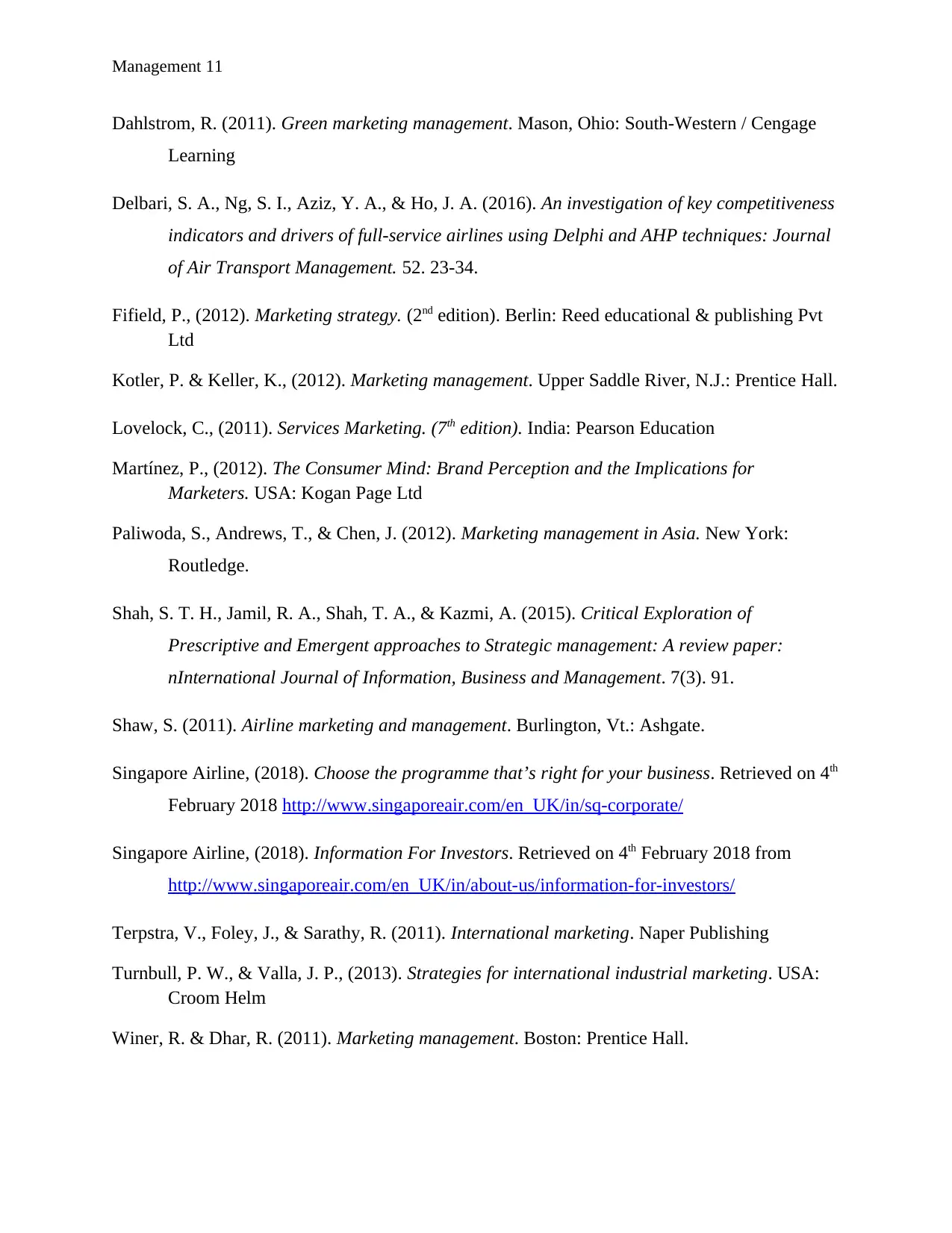
Management 11
Dahlstrom, R. (2011). Green marketing management. Mason, Ohio: South-Western / Cengage
Learning
Delbari, S. A., Ng, S. I., Aziz, Y. A., & Ho, J. A. (2016). An investigation of key competitiveness
indicators and drivers of full-service airlines using Delphi and AHP techniques: Journal
of Air Transport Management. 52. 23-34.
Fifield, P., (2012). Marketing strategy. (2nd edition). Berlin: Reed educational & publishing Pvt
Ltd
Kotler, P. & Keller, K., (2012). Marketing management. Upper Saddle River, N.J.: Prentice Hall.
Lovelock, C., (2011). Services Marketing. (7th edition). India: Pearson Education
Martínez, P., (2012). The Consumer Mind: Brand Perception and the Implications for
Marketers. USA: Kogan Page Ltd
Paliwoda, S., Andrews, T., & Chen, J. (2012). Marketing management in Asia. New York:
Routledge.
Shah, S. T. H., Jamil, R. A., Shah, T. A., & Kazmi, A. (2015). Critical Exploration of
Prescriptive and Emergent approaches to Strategic management: A review paper:
nInternational Journal of Information, Business and Management. 7(3). 91.
Shaw, S. (2011). Airline marketing and management. Burlington, Vt.: Ashgate.
Singapore Airline, (2018). Choose the programme that’s right for your business. Retrieved on 4th
February 2018 http://www.singaporeair.com/en_UK/in/sq-corporate/
Singapore Airline, (2018). Information For Investors. Retrieved on 4th February 2018 from
http://www.singaporeair.com/en_UK/in/about-us/information-for-investors/
Terpstra, V., Foley, J., & Sarathy, R. (2011). International marketing. Naper Publishing
Turnbull, P. W., & Valla, J. P., (2013). Strategies for international industrial marketing. USA:
Croom Helm
Winer, R. & Dhar, R. (2011). Marketing management. Boston: Prentice Hall.
Dahlstrom, R. (2011). Green marketing management. Mason, Ohio: South-Western / Cengage
Learning
Delbari, S. A., Ng, S. I., Aziz, Y. A., & Ho, J. A. (2016). An investigation of key competitiveness
indicators and drivers of full-service airlines using Delphi and AHP techniques: Journal
of Air Transport Management. 52. 23-34.
Fifield, P., (2012). Marketing strategy. (2nd edition). Berlin: Reed educational & publishing Pvt
Ltd
Kotler, P. & Keller, K., (2012). Marketing management. Upper Saddle River, N.J.: Prentice Hall.
Lovelock, C., (2011). Services Marketing. (7th edition). India: Pearson Education
Martínez, P., (2012). The Consumer Mind: Brand Perception and the Implications for
Marketers. USA: Kogan Page Ltd
Paliwoda, S., Andrews, T., & Chen, J. (2012). Marketing management in Asia. New York:
Routledge.
Shah, S. T. H., Jamil, R. A., Shah, T. A., & Kazmi, A. (2015). Critical Exploration of
Prescriptive and Emergent approaches to Strategic management: A review paper:
nInternational Journal of Information, Business and Management. 7(3). 91.
Shaw, S. (2011). Airline marketing and management. Burlington, Vt.: Ashgate.
Singapore Airline, (2018). Choose the programme that’s right for your business. Retrieved on 4th
February 2018 http://www.singaporeair.com/en_UK/in/sq-corporate/
Singapore Airline, (2018). Information For Investors. Retrieved on 4th February 2018 from
http://www.singaporeair.com/en_UK/in/about-us/information-for-investors/
Terpstra, V., Foley, J., & Sarathy, R. (2011). International marketing. Naper Publishing
Turnbull, P. W., & Valla, J. P., (2013). Strategies for international industrial marketing. USA:
Croom Helm
Winer, R. & Dhar, R. (2011). Marketing management. Boston: Prentice Hall.
1 out of 11
Related Documents
Your All-in-One AI-Powered Toolkit for Academic Success.
+13062052269
info@desklib.com
Available 24*7 on WhatsApp / Email
![[object Object]](/_next/static/media/star-bottom.7253800d.svg)
Unlock your academic potential
Copyright © 2020–2025 A2Z Services. All Rights Reserved. Developed and managed by ZUCOL.





